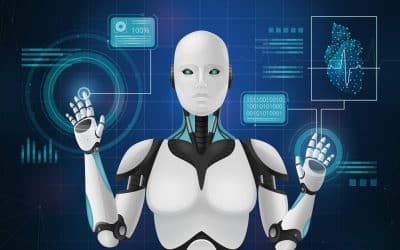AI, Machine Learning, and NLP technologies are some of the most exciting, groundbreaking advances currently available to us. They are revolutionizing how we interact with computers while helping solve society’s toughest challenges. These three effective technologies from which our modern society can benefit. They can handle massive amounts of data at a speed that humans cannot dream of, and they will change our perception of everything we do. But they are challenging to comprehend, particularly for those unfamiliar with the latest technologies.
The issue is that you should keep your head in the sand, hoping the best that AI, Machine Learning Language {ML}, and NLP will cease to exist. The world will change without you, and you’ll be left behind. In this article, we’ll examine the differences in AI, ML, and NLP and discuss their use cases in business.
What Is Artificial Intelligence {AI}?
AI is the capability of a digital robot or computer-controlled computer to complete tasks typically related to intelligent creatures. It is a broad and complicated concept. Creating, maintaining, and enhancing practical and useful AI requires much expertise. AI is the base of other concepts we’ll be discussing. In the absence of any other information, if somebody asked you to describe machine learning as opposed to.
Deep learning, or AI vs. a neural network, is easily said to be the larger area of study in which deep learning, machine learning, and NLP exist. You could consider AI an umbrella or tent that covers the other terms and is the core of the three concepts.
What Is Machine Learning {ML}?
ML is the study and application of algorithms that help make the most of information. Instead of human beings explicitly creating rules to solve issues, such as regression or classification, machine learning is an efficient method to draw these rules from the use of data. There are three distinct kinds of machine learning: supervised learning, non-supervised learning, and reinforcement (semi-supervised) learning. Supervised learning is the most popular and relies on labeled data to give direct input to algorithms.
Machine learning algorithms continuously make use of data to enhance their efficiency. Drawing on more significant and extensive datasets will make it more precise and efficient. In utilization management, machine learning can spot patterns in the patient population. This can assist in determining a patient’s proper condition, including whether they are outpatients or inpatients. As such, administrative personnel and healthcare professionals can focus on cases needing extra care.
What Is Natural Language Processing {NLP}?
Natural Language Processing (NLP) allows computers to understand human languages more readily. By analyzing sentence grammaticality and word meanings in-depth, NLP Machine Learning analyzes how sentences flow, uses algorithms to find meaning within specific word usages, and finds output results. Ultimately producing output data that matches the human understanding of this particular linguistic form. Also, it understands human speech and completes various tasks automatically.
The most famous examples of NLP are virtual assistants like Google Assist, Siri, and Alexa. NLP can recognize spoken and written texts and convert them into numbers, making them simple for machines to comprehend. Another popular application in NLP is chatbots. They aid support teams with problems by interpreting the standard language requirements and reacting promptly.
You utilize many other applications and probably come across NLP without even realizing it. When creating an email, text suggestions offer the ability to translate the content of a Facebook post written in a foreign language or even remove promotional emails that are not yours from your spam folder. NLP aims to help make human language—complex, confusing, and highly varied—simple for computers to comprehend.
Difference Between NLP, AI, And ML
These terms are often employed interchangeably, which means it is possible to cross your wires when trying to distinguish between these three.
The first thing to be aware of is that NLP and machine learning are two subsets that comprise artificial intelligence (AI), which refers to machines that emulate human cognitive capability and operate autonomously without human input. It is a term used to describe systems replicating cognitive abilities, such as learning from examples and solving issues. This encompasses a variety of applications, ranging from autonomous vehicles to systems that predict.
Natural Language Processing (NLP) examines how computers can comprehend the human voice and how they translate it. NLP machines can interpret written or spoken texts and perform tasks such as translating words and keyword extraction, subject classification, and more. However, machine learning is necessary to automate these tasks and give accurate answers. “Machine learning” refers to applying algorithms to enable machines to automatically learn and grow from their experiences without being explicitly programmed.
AI-powered chatbots utilize the NLP Model to discern users’ words. What they want to accomplish and machine learning is used to provide more accurate responses based on taking lessons from past interactions. Ultimately, AI, ML, and NLP are all interconnected yet distinct technologies with distinct goals and uses. Knowing the differences between these concepts will enable you to make educated decisions about software products while navigating the ever-changing technology landscape.
Use Cases Of AI
Even though AI for business applications is only in the early stages of fully realizing its potential, there are hundreds of AI uses. From AI-powered voice assistants or chatbots to enhanced facial recognition to protect against fraud and security. AI solutions have immensely contributed to businesses of all types and across multiple sectors.
AI-Powered Chatbots To Assist Customers
Like the AI-powered personal assistants found in homes, chatbots are an omnipresent illustration of AI in the business. Nearly everyone who has ever interacted with an eCommerce company’s Facebook page or a website’s automatic pop-up message of “Can I Help You?” has had a conversation with one. Customers who interact with a company can receive the assistance and information they require 24/7, usually helping make purchases. Chatbots for businesses generate higher revenues and reduce costs.
Lead Generation
Artificial Intelligence-powered leads generation software is currently positively affecting marketing and sales teams around the globe. When leads for sales are in the pipeline and talking to an agent for sales or a business development executive, the task of creating leads falls to humans. Companies have struggled to overcome one of the most challenging issues: getting enough leads in a pipeline, all with as little manual effort as possible. These issues can be solved with AI-powered solutions to marketing automation. On one side of the spectrum, machine learning and algorithms for sentiment analysis collect data from the web and social media to provide information about prospects.
Recruitment And HR On-Boarding
Human Resources and Recruitment is another sector where AI-powered automation has made an impressive and visible impact. Instead of entrusting employees with manually-based tasks, AI is being used inventively and effectively, such as using an HR chatbot that assists with HR-related tasks. From automated candidate sourcing and sifting through resumes for keywords and skills to candidate rediscovery/re-targeting and candidate matching. Through a potent combination of automation and social media, AI-powered solutions can be used in a recruitment and HR environment, making locating, selecting, and integrating new talent more straightforward.
Security Of IT And Digital Information
Traditional IT security must be able to stop the increasing threat of cyber-attacks. Hackers and cybercriminals are constantly changing the kinds of attacks they can use. In many instances, well-organized dark web organizations collaborate with skilled developers using robots and AI to push attacks in the right direction. Security software and firewalls that block the threat from entering a system aren’t enough anymore. With AI-powered security, you monitor systems in real-time and determine if cybercriminals have already hacked the initial security layer.
The Analysis Of Sentiment On Social Media
In the same way, AI-powered chatbots and assistants are gaining traction in the home, on social networks, and on other platforms; there are additional tools for analyzing sentiment that brands use to track reputation on the internet. Using machine learning, massive data, and natural language processing, AI devices can be developed to track brand mentions and enable companies to implement automated marketing. Systems that can be used to promote promotions and, in certain instances, real-time communication whenever a mention needs the intervention of a human being, generally to stop escalating a complaint and resolve a customer issue.
Machine Learning Use Cases
We live in a time driven by machine learning apps, whether the voice assistants on our smartphones or Face Unlock, the Face Unlock feature, the price increases on ride-hailing applications, the filtering of emails, and more. There are many machine learning apps that you use in your daily life without knowing about them. ML can be used for a broad range of applications in the corporate world since its capabilities make it ideal for the demands of an ever-growing market. Intelligent automation has helped enterprises use low-cost, high-quality AI and ML applications to replace lower-skilled employees.
Image Classification
Image classification is the method that allows algorithms to study images and find out what they are made of. While it’s easy for human eyes to examine an image and see what it is, AI algorithms must be developed to assist computers in analyzing images. Nowadays, image classification algorithms are comparable to human abilities. With the help of AI algorithms designed to analyze images, businesses can use image classification tools that dramatically improve efficiency and reduce the risk of mistakes. Companies can use the exact solutions to carry out processes like know-your-customer or identity verification.
Classification of images as a machine-learning method has gained much popularity in the business sector due to its ability to break existing systems designed to serve the same purpose. In the past, humans were required to sort through vast amounts of data and categorize them.
Text Parsing
Artificial intelligence algorithms can be trained to recognize and process text written by humans. This is known as text parsing and falls under natural language processing. By instilling the principles of grammar and language in an AI, it is possible to process a huge amount of data in less time. Text parsing is beneficial in analyzing existing data and generating new data, whether through user-generated content or competitor material.
This is expected to bring numerous advantages for businesses with large amounts of text-based data. Text parsing can potentially replace many low-skilled workers in these kinds of businesses. With the help of AI to process large quantities of text at a rapid pace, companies can gain from solutions for text parsing. Text parsing technology allows computers to interpret vast volumes of text in the same way that humans can. This lets companies use a fast search engine for simple tasks and a more sophisticated algorithm for more advanced requirements like a bibliography. This eliminates the necessity of hiring labor with no skills to read texts, thus improving the company’s bottom line.
Recommendation Engines
Algorithms can be trained to suggest items to users by gathering user data and using neural networks and deep learning. These algorithms, or recommendation engines, are generally employed to gather and store customer preference information. When you know what a user prefers or dislikes, you can understand what the consumer wants to eat or buy. This model can be utilized to offer personalized recommendations to the consumer.
Nowadays, recommendation engines are the standard for creating and customizing content for every user. Amazon uses recommendation engines to recommend products that the user might enjoy from previous purchases, and Netflix utilizes the technology to suggest films and shows in accordance with the user’s preferences. Recommendation engines enhance the customer experience substantially.
Recommendation engines are also an exciting new approach to customer service and satisfaction, as demonstrated by their widespread use across various sectors. They allow businesses to dramatically improve the customer experience they provide through the precise analysis and processing of user data. For instance, Amazon offers a customized homepage to millions of customers every day. While this might appear small, putting suggested products on the home page significantly boosts customer conversion probability.
Predictive Modeling
Predictive modeling is a machine-learning solution that mines large amounts of data to forecast the outcome of scenarios. The predictions can be utilized to help businesses make more informed decisions. Modeling algorithms that predict the future give a forecast of the future based on historical information, which allows businesses to make business decisions in anticipation of these predictions. Large companies with data could employ machine-learning models that can identify patterns within the data. These patterns determine areas of pain within the company’s processes or opportunities to make money. Predictive models are also frequently used because they offer the chance to make well-informed decisions and improve existing processes by identifying patterns in the company’s data.
For instance, predictive modeling algorithms could determine the desire for a particular product within a retail store. This information can be utilized to choose the best quantity of inventory to be shipped and reduce the cost of overhead. An effective competitive edge that reduces costs while simultaneously increasing sales and eliminating shortages is cost savings.
Customer Service
Automated algorithms can be trained to function as customer service representatives through natural language processing based on the most frequent customer complaints. AI has taken over the customer service industry, with numerous chatbots and natural language processing software available. Chatbots have successfully taken on the function of customer-facing executives since they can respond to customers quickly. After being instructed on a set of common customer complaints and solutions, chatbots can offer simple and easy solutions to customers promptly. If a customer’s issue is not addressed, it’s transferred to a human customer service agent.
Additionally, NLP is heavily employed to process large amounts of support and training materials to build a knowledge database that humans can use to solve problems quickly. B2C firms previously expended many resources in this particular segment. However, when AI became a reality, these costs were reduced to a considerable extent.
Use Cases Of NLP
NLP Tools can help businesses understand how customers view them across various communication channels, such as emails, product reviews, social media posts, surveys, etc. In addition, AI tools can be utilized to study how people express their opinions about businesses.
Here are a few of the most essential uses of NLP in the business world:
Sentiment Analysis
Sentiment analysis detects text emotions and categorizes opinions as positive, neutral, harmful, or neutral. You can observe the process by copying text into this tool to analyze sentiment. Companies can leverage social media posts, product reviews, and online surveys to understand consumers’ feelings about their brands or products. For instance, you can examine tweets that mention your company in real time and identify the comments of angry customers in a matter of minutes.
You may like to distribute an online survey to learn what customers think of the quality of your customer service. By analyzing open-ended responses to the NPS survey, you can determine what aspects of your customer service receive favorable or unfavorable feedback.
Language Translation
Machine translation technology has improved enormously in the last few years. Translation tools allow businesses to communicate with customers in various languages, enhancing their global communications or gaining entry into new markets. Training translation tools to understand specific terms from fields like medicine or finance allows you to avoid mistranslations, which often happen with generic tools for translation.
Text Extraction
Text extraction lets you extract pre-defined information from text. If you have to deal with huge volumes of information, it can assist you in identifying and extracting pertinent keywords, features (like the codes for products, colors, and specifications), and entity names (like names of individuals and locations, corporate names, email addresses, etc.). Businesses can extract text to find the critical words in legal documentation, find the most important words in customer support tickets, extract specifications for products from a text paragraph, and many other applications. Does this sound intriguing? This is a tool for keyword extraction that you could try.
Chatbots
Chatbots are AI machines designed to communicate with humans using either speech or text. Their use to assist customers is increasing because of their capability to provide 24-hour assistance (speeding responses). Also handle multiple inquiries simultaneously, and relieve human agents from having to answer repeated questions. Chatbots constantly learn from each interaction and become better at understanding users’ intent. Thus, you can count on them to complete routine and easy tasks. If they are faced with an issue with a customer that they aren’t in a position to answer, they’ll relay it to an actual human agent.
Topic Classification
Topic classification can help you categorize text that is not structured into categories. It’s an excellent method for businesses to gain insights through customer feedback. Imagine you’re looking at hundreds of open-ended responses to NPS surveys. What percentage of responses refer to the customer service you provide? What proportion of customers speak regarding “Pricing”?
This topic classifier will help you understand NPS customer feedback; you’ll be able to have all the data you need in a matter of minutes. You can also use topic classification to streamline the process of categorizing support tickets received and then automatically sending them to the appropriate person.
In Summary
Artificial Intelligence (AI), machine learning (ML), and NLP technologies are expected to impact various sectors significantly. Although these terms are frequently employed vaguely and ambiguously, they are distinct but interconnected concepts with different purposes and applications. As AI technology becomes widely used and mature, the definitions of these terms will become more precise and well-known. On the other hand, the moment we create a generalized AI, the definitions could become irrelevant.
Understanding their subtleties allows us to better understand their impact on different industries. As the technology continues to develop, advance, and mature, we can anticipate its more significant impact. In the end, understanding the differentiators and uses that lie behind AI, ML, and NLP is crucial to reaping their benefits and transforming an improved world.











